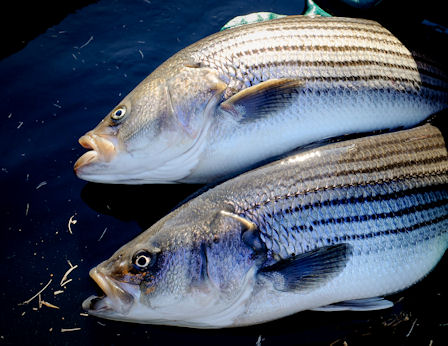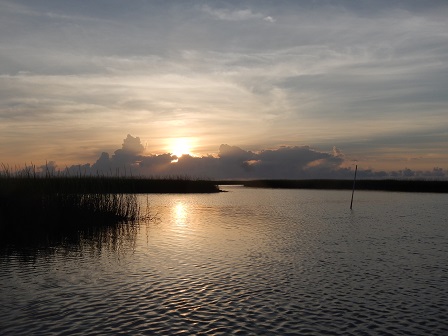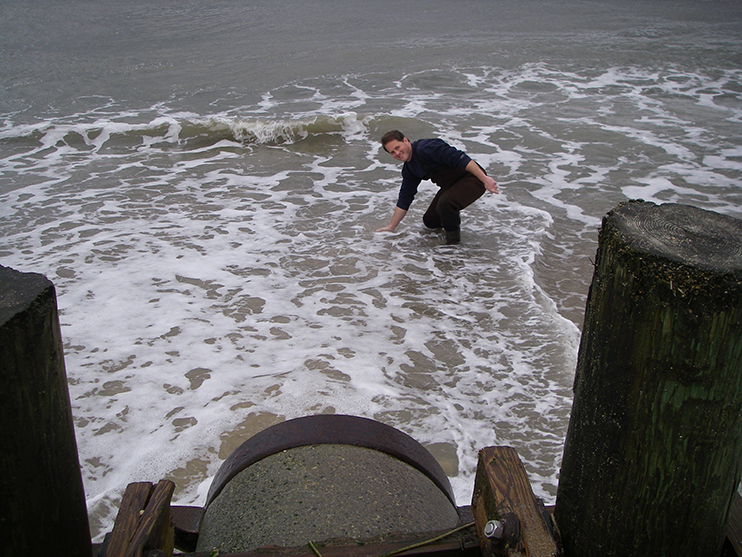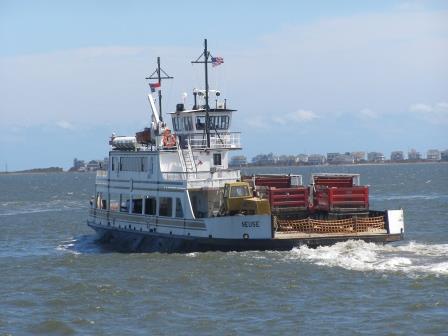SEA SCIENCE: Research Examines Impacts And Options For Fish Farming

IN THE WINTER 2006 ISSUE OF COASTWATCH, KATHLEEN ANGIONE INTRODUCED READERS TO WASTE AND WATER QUALITY ISSUES SURROUNDING EASTERN NORTH CAROLINA’S HYBRID STRIPED BASS AQUACULTURE INDUSTRY. IN THIS ISSUE, ANGIONE FOLLOWS UP WITH CURRENT RESEARCH ON EFFLUENT DISCHARGE AND WATER CONSERVATION METHODS.
In Hollywood, they say any publicity is good publicity for celebrities. In Aurora, N.C., any publicity may be too much for hybrid striped bass farmers, who are local celebrities in their own right.
North Carolina has nearly 20 hybrid striped bass growers, and most operate near Aurora, a small community in Beaufort County. A cross between the white bass and the striped bass, hybrids are popular in the sushi and sashimi markets of the Northeast, selling for $3 per pound on the live market. In an economy where independent agriculture has hit a downturn nationally, the county’s hybrid striped bass farmers continue to do well for themselves and turn profits year after year.
But with celebrity comes scrutiny. The farms are under the public microscope for the wastewater, or effluent, they discharge from their earthen fish ponds into estuarine creeks that empty into the Pamlico Sound.
“The water is green coming out of these ponds — it is easy to see,” says Harry Daniels, a Sea Grant researcher from North Carolina State University told Coastwatch back in 2005. “People associate algae with water that kills fish.”
Complaints from the public about green water have remained steady for the last several years, according to Al Hodge, regional supervisor for surface water for the N.C. Division of Water Quality (DWQ).
Traditionally, if a pond’s water quality began deteriorating, hybrid striped bass farmers would drain a foot or more of water into nearby creeks and pump in fresh water from a well, a technique known as “flushing.” Once or twice a year, farmers drained each pond entirely after a harvest to make sure all fish were removed.
Effluent entering the creeks from fishponds is usually high in nitrogen and phosphorus from the feed and waste cycles of the fish. In high quantities, these nutrients are linked to increased algae growth in streams, which cuts off oxygen for other aquatic plants and animals.
Various permits for pond discharge exist at both state and federal levels, Hodge notes.
However, DWQ recently determined that three of Aurora’s creeks receiving discharge from hybrid striped bass farms are classified as “zero flow” — a designation that prohibits the discharge of water containing any nutrients or organic matter.
Because an immediate end to all discharge would shut down the hybrid striped bass industry, each farm has an option to apply to the state for a “special order by consent,” or SOC, according to Marc Turano, aquaculture specialist for North Carolina Sea Grant. These special orders allow farmers to discharge for a set period of time while they explore alternative methods for recycling and reusing water within their farms.
“The only means to satisfy these complaints — and to bring the producers into compliance with effluent standards — is to drastically reduce or eliminate effluents from farms,” Daniels says. “It’s important that we do research on these methods now so that we can generate data that gives farmers more options.”
WAKE-UP CALL
Daniels’ research into those methods began with a flow study involving three of Aurora’s creeks to determine just how far effluent from hybrid striped bass ponds travels. With the help of a North Carolina Sea Grant mini grant, Daniels used a nontoxic, red dye to trace the water flow from a one-time draining of an entire hybrid striped bass pond.
“We could see how far it [the dye] went into the creek, and we measured the dilution as it went down the creek,” he explains.
He found the dye traveled a maximum distance of a quarter-mile or less in all three creeks. Those results led to a year-long water monitoring study in 2007 to determine how much hybrid striped bass farmers were adding to the natural nutrient levels of the creeks. Half of the funding for the $15,000 study came from the N.C. Cooperative Extension Service and North Carolina State University’s Agricultural Research Service. The other half was put up by a group of hybrid striped bass farmers themselves, notes Turano, who participated in the study.
“We wanted people to know we are serious about this [effluent] issue,” explains Nancy Sugg, manager of Castle Hayne Farms in Aurora, which contributed funds to the study.
Daniels and Turano chose monitoring sites that were easy to find and visible to the public, such as roadside ditches. Based on the dye study, the scientists identified sample sites they knew received pond effluent, as well as several “control” sites not influenced by effluent.
As expected, Daniels and Turano found that nutrient levels were high in areas near pond discharge. They also discovered many of the control sites exceeded government standards for acceptable nutrient levels.
There is considerable natural variation among the area’s wide, shallow creeks, Daniels notes, adding that there could be several explanations for the high nutrient levels in the so-called “pristine” creeks that were tested.
The results of the monitoring study, along with the finite SOCs, proved a wake-up call for farmers, he adds. Many already are experimenting with alternatives to flushing and draining ponds.
“I saw the writing on the wall and started cutting back the discharge,” says Scott Deil,
proprietor of Pamlico Fish Farm in Aurora.
“Sooner or later, regulations are going to force us to make changes to the way we do things.”
To cut down on flushing but still keep his fish healthy, Deil began to regularly monitor the ammonia levels in the ditch near the pond. If the levels became too high, he cut back the amount of feed his fish received. He also added a third aerator to his pond and ran the units at different times of day, depending on the dissolved oxygen readings.
Deil estimates he reduced effluent discharge by 75 percent last year, and broke even on the farm’s electric bill despite rising fuel costs.
“I didn’t have to run the pump as often,” he says of the diesel machine used to draw water from his well. “I’m one of the smaller operations out here. I have to work smarter.”
Sugg says Castle Hayne Farm, which has 41 ponds and is one of the area’s larger operations, has reduced its effluent by 50 percent. She has lowered the number of fish per pond, which helps keep the water cleaner, and stopped flushing the ponds as frequently.
“We’ve cut way down,” Sugg adds. “We’ve had too — we’re on the hot seat.”
ZERO DISCHARGE
In 2007, Daniels received a two-year N.C. Fishery Resource Grant (FRG) to continue studying methods for water conservation and effluent reduction on hybrid striped bass farms. The FRG program is funded by the N.C. General Assembly and administered by North Carolina Sea Grant. Daniels says the ultimate goal is to achieve zero discharge for all hybrid striped bass farms, but his FRG project will focus on one pond at a time.
“The first step is to get zero discharge from an individual pond,” he says.
In the past, growers harvested hybrids using large seines and drained an entire pond to catch any stragglers that might cannibalize the next batch of smaller fish. An empty pond was left to dry out in the sun to kill any snails or parasites that might cause problems for the future stock.
One of the zero-discharge methods Daniels plans to test involves leaving water in a pond after a harvest and treating it with rotenone to kill any remaining fish. Rotenone occurs naturally in the roots and stems of several plants. The chemical dissipates quickly, and does not affect the next fish stock, Daniels notes.
The banks of the pond are then treated with a copper sulfate solution to prevent snails and parasites — specifically the yellow grub — from damaging the stock. The yellow grub relies on the Ram’s Horn snail to complete its lifecycle, and the best way to keep grubs under control is to make sure snail populations are low.
Daniels also plans to test another zero-discharge method where water would be moved from one pond to another for treatment. The engineering and economics of this method are complex, but at least it allows a pond to dry out, he notes.
“The really important thing we have to look at here is whether or not the grub problem gets greater in those ponds where we don’t release the water,” Daniels says. “In the past that has happened, and that’s one reason why they had to release that water.”
Sugg already is experimenting with treating water post-harvest and restocking ponds afterward. She says the method works fairly well, and it definitely contributed to the 50 percent reduction in effluent that Castle Hayne achieved last year.
Daniels expects to have production and economic feasibility data on each zero-discharge method by early next year. Sugg and Deil hope that information will help them further reduce effluent from their ponds. In the meantime, they continue to do their best in the face of public pressure and confusing regulations, Sugg says.
“At one time people just thought we were pure evil. We’ve got to get people to see that we’re trying to do the right thing.”
This article was published in the Spring 2008 issue of Coastwatch.
For contact information and reprint requests, visit ncseagrant.ncsu.edu/coastwatch/contact/.


